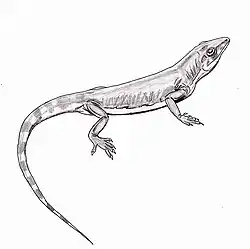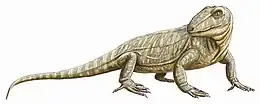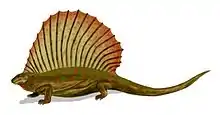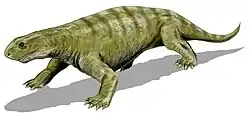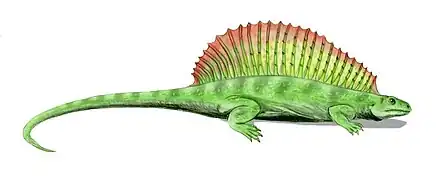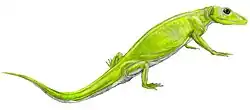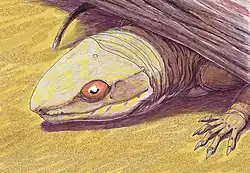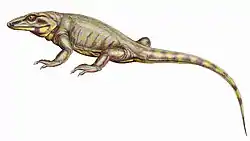Anexo:Pelicosaurios
Esta lista de pelicosaurios es un intento de crear un listado comprensible de todos los géneros incluidos en este grupo. La lista incluye todos los géneros aceptados por la comunidad científica, pero también aquellos que hasta el momento se han considerado inválidos, dudosos (nomen dubium), o no se han publicado formalmente (nomen nudum), también como los sinónimos o nombres más aceptados, y géneros que dejaron de ser considerados pelicosaurios.
La lista contiene hasta el momento 79 nombres genéricos.
Convenciones de nombres y terminología
La convención de nombres y terminología siguen el Código Internacional de Nomenclatura Zoológica (CINZ). Los nombres técnicos utilizados comprenden:
- Sinónimo más moderno: Es un nombre que describe el mismo taxón que ya ha sido publicado previamente con otro. Si dos o más géneros están formalmente designados y posteriormente son asignados a un mismo género, el primero en ser publicado (en orden cronológico) es el sinónimo más antiguo, que tiene prioridad y debe mantenerse, y todas las otras instancias son sinónimos más modernos y no deben usarse.
- Nomen nudum (es el latín de «nombre desnudo»): Es un nombre que se ha publicado, pero no no ha sido formalmente reconocido por el (CINZ).
- Nomen oblitum (es el latín de «nombre olvidado»): Es un nombre que no se ha utilizado en los últimos cincuenta años por la comunidad científica luego de ser propuesto originalmente.
- Nombre utilizado: Un nombre que esta formalmente publicado pero que ya ha sido asignado a otro taxón. Este segundo nombre es inválido (como todos los usos subsecuentes) y el nombre debe ser reemplazado.
- Nomen dubium (es el latín para «nombre dudoso»): Es un nombre que describe un fósil en ausencia de un rasgo distintivo que lo defina. Como esto puede ser una designación subjetiva y controversial, este término no se usa en esta lista.
Lista
|
| ||||||||||||||||||||||||||||||||||||||||||||||||||||||||||||||||||||||||||||||||||||||||||||||||||||||||||||||||||||||||||||||||||||||||||||||||||||||||||||||||||||||||||||||||||||||||||||||||||||||||||||||||||||||||||||||||||||||||||||||||||||||||||||||||||||||||||||||||||||||||||||||||||||||||||||||||||||||||||||||||||||||||||||||||||||||||||||||||||||||||||||||||||||||||||||||||||||||||||||||||||||||||||||||||||||||||||||||||||||||||||||||||||||||||||||||||||||||||||||||||||||||||||||||||||||||||||||||||||||||||||||||||||||||||||||||||||||||||||||||||||||||||||||||||||||||||||||||||||||||||||
Véase también
Referencias
- Berman, D. S.; Sumida, S. S.; Lombard, R. E. (1997). «Biogeography of primitive amniotes». En Sumida, S. J. & Martin, K. L. M, ed. Amniote Origins - Completing the Transition to Land. Academic Press. pp. 85-140. ISBN 0126764603.
- Romer, A. S. (1937). «New genera and species of pelycosaurian reptiles». Proccedings of the New Inglaterra Zoological Club XVI: 90-96.
- Olson, E. C. & Barghusen, H. (1962). «Permian vertebrates from Oklahoma and Texas». Oklahoma Geological Survey 59: 1-20.
- Bruner, J. C. (1991). «A catalogue of Type Specimens of Fossil Vertebrates in the Field Museum of Natural History. Classes Amphibia, Reptilia, Aves and ichnites». Geology 22: 1-68.
- Reisz, R.R.; Laurin, M. & Marjanovic, D. (2010). «Apsisaurs witteri from the lower Permian of Texas: yet another small varanopid synapsid, not a diapsid». Journal of Vertebrate Paleontology 30 (5): 1628-1631. doi:10.1080/02724634.2010.501441.
- Reisz, R. R. & Dilkes, D. W. (2003). «Archaeovenator hamiltonensis, a new varanopid from the Carbonífero Superior of Kansas». Canadian Journal of Earth Science 40: 667-678. doi:10.1139/e02-063.
- Carroll, R. L. (1988). Vertebrate Paleontology and Evolution. W. H Freeman Company. p. 688. ISBN 0716718227.
- Langston, W. (1965). «Oedalops campi (Reptilia: Pelycosauria) new genus and species from the Pérmico Inferior of New Mexico and the family Eothryrididae». Bulletim of Texas Memorial Museum 9: 1-45.
- Reisz, R. R.; Wilson, H. & Scott, D. (1997). «Varanopseid Sinapsid skeletal elements from Richards Spur, a Pérmico Inferior fissure fill near Fort Sill». Oklahoma Geology Notes 57: 160-170.
- Lucas, S. G. (2006). «Global Permian tetrapod biostratigraphy and biochronology». En Lucas, S. G.; Cassinis, G. & Schneider, J. W, ed. Non-marine permian biostratigraphy and biochronology. Geological Society. pp. 65-94. ISBN 1862392064.
- Olson, E. C. (1962). «Late Permian Terrestrial Vertebrates, U.S.A. and U.S.S.R.». Transactions of the American Philosophical Society 52: 1-196.
- Modesto, S. P. & Reisz, R. R. (2008). «New material of Colobomycter pholeter, a small parareptile from the Pérmico Inferior of Oklahoma». Journal of Vertebrate Paleontology 28 (3): 677-684. doi:10.1671/0272-4634(2008)28[677:NMOCPA]2.0.CO;2.
- Jörg Fröbisch, Rainer R. Schoch, Johannes Müller, Thomas Schindler and Dieter Schweiss (2011). «A new basal sphenacodontid synapsid from the Late Carboniferous of the Saar-Nahe Basin, Germany». Acta Palaeontologica Polonica 56 (1): 113-120. doi:10.4202/app.2010.0039.
- Hook, R. W. & Hotton, N. (1991). «A new sphenacodontid pelycosaur (Sinapsida) from the Wichita Group, Pérmico Inferior of north-central Texas». Journal of Vertebrate Paleontology 11: 37-44.
- Evans, D. C.; Maddin, H. C. & Reisz, R. R. (2009). «A Re-evaluation of Sphenacodontid Sinapsid Material from the Pérmico Inferior Fissure Fills near Richards Spur, Oklahoma». Palaeontology 52 (1): 219-227. doi:10.1111/j.1475-4983.2008.00837.x.
- Sidor, C.A. & Hopson, J.A. (1995). «The taxonomic status of the Pérmico Superior eotheriodont therapsids of the San Angelo Formation (Guadalupian), Texas». Journal of Vertebrate Paleontology 15 (suppl. 3): 53A.
- Dixon, D.; Cox, B.; Savage, R. J. G. & Gardine, B., ed. (1992). The Macmillan Illustrated Encyclopedia of Dinosaurs and Prehistoric Animals. Collier Books. p. 312. ISBN 0020429819.
- Berman, D. S.; Reisz, R. R.; Martens, T. & Henrici, A. C. (2001). «A new species of Dimetrodon (Sinapsida: Sphenacodontidae) from the Pérmico Inferior of Alemania records first occurrence of genus outside North America». Canadian Journal of Earth Science 38: 803-812.
- Benton, M. J. & Donoghue, P. C. J. (2006). «Paleontological Evidence to Date the Tree of Life». Molecular Biology and Evolution 24 (1): 26-53. doi:10.1093/molbev/msm017.
- Modesto, S. P. & Reisz, R. R. (1990). «Taxonomic status of Edaphosaurus raymondi Case». Journal of Paleontology 60 (6): 1049-1051.
- Reisz, R. R. (1986). «Pelycosauria». En Sues, H. D, ed. Handbuch der Paläoherpetologie Part 17-A. Pfeil-Verlag. pp. 1-102. ISBN 978-3-89937-032-4.
- Dilkes, D. W. & Reisz, R. R. (1996). «First record of a basal Sinapsid ('Mammal-like Reptile') in Gondwana». Proceedings of The Royal Society B Biological Sciences 263: 1165-1170. doi:10.1098/rspb.1996.0170.
- Modesto, S. P. & Rybcynski, N. (2001). «The amniote faunas of the Rusian Permian: implications for Late Permian terrestrial vertebrate biogeography». En Benton, M. J.; Shishkin, M. A.; Unwin, D. M.; Kurochkin, E. N, ed. The Age of Dinosaurs in Rusia and Mongolia. Cambridge University Press. pp. 17-34. ISBN 052154582X.
- Modesto, S. P. (1994). «The Pérmico Inferior Sinapsid Glaucosaurus from Texas». Paleontology 37 (1): 51-60.
- Kemp, T. S. (2005). The Origin & Evolution of Mammals. Oxford University Press. p. 342. ISBN 0-19-850761-5.
- Reisz, R. R. & Modesto, S. P. (2007). «Heleosaurus scholtzi from the Permian of South Africa: a varanopid Sinapsid, not a diapsid reptile». Journal of Vertebrate Paleontology 27 (3): 734-739. doi:10.1671/0272-4634(2007)27[734:HSFTPO]2.0.CO;2.
- Kissel, R. A. & Reisz, R. R. (2004). «Sinapsid fauna of the Upper Pennsylvanian Rock Lake Shale near Garnett, Kansas and the diversity pattern of early amniotes». En Arratia, G.; Wilson, M. V. H. & Cloutier, R, ed. Recent Advances in the Origin and Early Radiation of Vertebrates. Pfeil-Verlag. p. 703. ISBN 978-3-89937-052-2.
- Paton, R. L. (1974). «Pérmico Inferior pelycosaurs from the english midlands». Paleontology 17 (3): 541-552.
- Reisz, R. R. (2005). «Oromycter, a New Caseid from the Pérmico Inferior of Oklahoma». Journal of Vertebrate Paleontology 25 (4): 905-910. doi:10.1671/0272-4634(2005)025[0905:OANCFT]2.0.CO;2.
- Sumida, S. S. (1989). «Reinterpretation of vertebral structure in the Pérmico Temprano pelycosaur Varanosaurus acutirostris (Amniota, Sinapsida)». Journal of Vertebrate Paleontology 9: 451-158.
- Anderson, J. S. & Reisz, R. R. (2004). «Pyozia mesenensis, a new small varanopid (Sinapsida, Eupelycosauria) from Rusia: “Pelycosaur” diversity in the Pérmico Medio». Journal of Vertebrate Paleontology 24 (1): 173-179. doi:10.1671/1940-13.
- Eberth, D. A. & Brinkman, D. (1983). «Ruthiromia elcobriensis, a new pelycosaur from El Cobre Canyon, New Mexico». Breviora 474: 1-27.
- Reisz, R. R. & Berman, D. S. (1985). «Scoliomus puercensis Williston and Case, 1913, identified as a junior synonym of Sphenacodon ferox Marsh (Reptilia, Pelycosauria)». Canadian Journal of Earth Sciences 22 (8): 1236-1239. doi:10.1139/e85-126.
- Reisz, R. R. & Laurin, M. (2004). «A reevaluation of the enigmatic Permian Sinapsid Watongia and of its stratigraphic significance». Canadian Journal of Earth Science 41: 377-386. doi:10.1139/e04-016.
